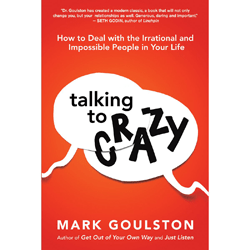The book “Talking to Crazy” by Dr. Mark Goulston has helpful tips for all who are frustrated or at their wits’ end with irrational and impossible people. The author makes “crazy” easy to understand and recognize. Best of all, he uses simple language to explain the complexity of when brains turn upside down to spin behavior out of control.
 Although the book is printed by the American Management Association and targets workplace “craziness,” it branches out to include personal and family-related irrational situations, reminding us that within this context, “crazy” is both human and situational.
Although the book is printed by the American Management Association and targets workplace “craziness,” it branches out to include personal and family-related irrational situations, reminding us that within this context, “crazy” is both human and situational.
According to Goulston, the science behind the pathways that lead to irrational behavior are: coddling, criticizing and ignoring. He explains each in its environmental context and how the brain functions and reacts to stimuli if it has developed within these three environments. In a nutshell, these environments tend to create baggage that results in creating MOs – modes of operation or behavior – that create problems in interpersonal relations.
The nine distinct MOs of irrational people are described in detail by Goulston so that each one can be seen as a catalyst for irrational behavior. The value of the book is learning how one can overcome and diffuse a person’s destructive manner – either at work or in relationships in general. The nine MOs are: emotional, overly logical, manipulative and needy, fearful, hopeless/withdrawn, martyred, bullying, know-it-all and sociopathic.
One surprisingly effective tip on how to deal with these dysfunctional MOs is to “lean in” rather than confront. The author gives very practical examples of how to diffuse anger and hostility. The “Belly Roll,” the “A-E-U (apologize, empathize and uncover) technique,” “Time Travel” and “Coup Contrecoup” are some of the many diffusion techniques that are explained and demonstrated with dialogue; how in real situations, angry confrontations were gradually reduced to understanding and positive interactions. The methods make sense and give the reader choices on how to deflect and repair irrational behavior.
I found the section in the beginning of the book on brain functions most intriguing. It was an easy read for me, even though I have little background in neuro science matters. The author discusses the concept of the “flipped brain” by explaining how our brain is made of three parts: The first part is the primitive lower brain, the reptilian brain that focuses on survival (food, sex, escape or attack). The second part is the paleomammalian middle brain, which is the emotional driver of joy, pleasure, sadness or hate. The highest and most evolved part of our brain is the neomammalian brain, which controls impulses, is logical and helps us make smart decisions.
We are reminded that brains develop at different stages and if we finally are in the third stage of the brain, the other parts are still actively engaged, yet less dominant. However, stressful situations can “flip” our brain to function at the more primitive level, which can dominate escape or attack impulses. This means we may become unpredictable and some may become stuck in behaviors that the author calls “crazy.”
My only regret about this book is that I did not read it sooner, when it would have been very helpful in dealing with some “crazy” situations. It’s a good book that may “set us free.”
Lucia Worthington teaches business and management at Clark College. She enjoys her periodic benign craziness when logic simply needs a rest. To recommend a book for review, email bookreviews@vbjusa.com.


